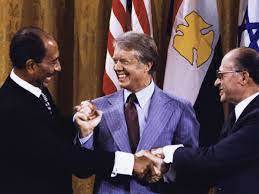The Camp David Accords were a series of agreements signed by Egyptian President Anwar Sadat and Israeli Prime Minister Menachem Begin following nearly two weeks of secret negotiations at Camp David, the historic country retreat of the president of the United States. President Jimmy Carter brought the two sides together, and the accords were signed on September 17, 1978. The landmark agreement stabilized the fractious relations between Israel and Egypt, though the long-term impact of the Camp David Accords remains up for debate.

Background
The United Nations (UN) voted in 1947 to partition Great Britain’s Palestine mandate—to be established were a Jewish state, an Arab state, and an independent Jerusalem under a UN trusteeship. Arabs opposed partition. When the mandate ended on May 15, 1948, and Israel proclaimed its independence, the first Arab-Israeli war erupted. No separate state for Arab Palestinians (i.e., Palestinians) was established. Egypt took control of the Gaza Strip along the Mediterranean Sea, and Jordan assumed sovereignty over the territory between Israel’s eastern border and the Jordan River (the West Bank), including East Jerusalem. During the Six-Day War of June 1967, Israel occupied those territories as well as the Golan Heights—a patch of Syrian land on Israel’s north eastern border—and Egypt’s Sinai Peninsula. Following his election as U.S. president, Carter committed himself to working toward a comprehensive Middle East peace settlement based on UN Resolution 242 (November 1967), which called for the withdrawal of Israel from the occupied territories, Arab recognition of and peace with Israel (stipulations that the Arab states had refused to agree to), and a just settlement to the problem of Palestinian refugees displaced by the establishment of Israel and the 1967 war.
Early in his presidency, Carter met with leaders of the Middle East and was especially encouraged by President Sadat. Sadat wanted the Israeli-occupied Sinai returned to Egypt, as well as peace for his people and a stronger relationship with the United States. The U.S. president also met with Begin, who had only recently become prime minister, and found him willing to consider the measures that Carter had discussed with Sadat.
In November 1977 Sadat initiated direct contacts with Israel and made a dramatic visit to Jerusalem, where he spoke to the Israeli Knesset (parliament). However, a reciprocal visit by Begin was unsuccessful, and no progress was made toward peace. Rosalynn Carter, the U.S. first lady, then suggested to her husband that he invite Sadat and Begin to Camp David, in rural Maryland, where the relative privacy and seclusion might provide a setting for a breakthrough.
Preamble
The search for peace in the Middle East must be guided by the following:
The agreed basis for a peaceful settlement of the conflict between Israel and its neighbours is United Nations Security Council Resolution 242, in all its parts.
After four wars during 30 years, despite intensive human efforts, the Middle East, which is the cradle of civilization and the birthplace of three great religions, does not enjoy the blessings of peace. The people of the Middle East yearn for peace so that the vast human and natural resources of the region can be turned to the pursuits of peace and so that this area can become a model for coexistence and cooperation among nations.
The historic initiative of President Sadat in visiting Jerusalem and the reception accorded to him by the parliament, government and people of Israel, and the reciprocal visit of Prime Minister Begin to Ismailia, the peace proposals made by both leaders, as well as the warm reception of these missions by the peoples of both countries, have created an unprecedented opportunity for peace which must not be lost if this generation and future generations are to be spared the tragedies of war.
The provisions of the Charter of the United Nations and the other accepted norms of international law and legitimacy now provide accepted standards for the conduct of relations among all states.
To achieve a relationship of peace, in the spirit article 2 of the United Nations Charter, future negotiations between Israel and any neighbor prepared to negotiate peace and security with it are necessary for the purpose of carrying out all the provisions and principles of Resolutions 242 and 338.
Peace requires respect for the sovereignty, territorial integrity and political independence of every state in the area and their right to live in peace within secure and recognized boundaries free from threats or acts of force. Progress toward that goal can accelerate movement toward a new era of reconciliation in the Middle East marked by cooperation in promoting economic development, in maintaining stability and in assuring security.
Security is enhanced by a relationship of peace and by cooperation between nations which enjoy normal relations. In addition, under the terms of peace treaties, the parties can, on the basis of reciprocity, agree to special security arrangements such as demilitarized zones, limited armaments areas, early warning stations, the presence of international forces, liaison, agreed measures for monitoring and other arrangements that they agree are useful.
Egypt-Israel relations
Egypt-Israel undertake not to resort to the threat or the use of force to settle disputes. Any disputes shall be settled by peaceful means in accordance with the provisions of Article 33 of the U.N. Charter.
In order to achieve peace between them, I the parties agree to negotiate in good faith with a goal of concluding within three months from the signing of the Framework a peace treaty between them while inviting the other parties to the conflict to proceed simultaneously to negotiate and conclude similar peace treaties with a view the achieving a comprehensive peace in the area. The Framework for the Conclusion of a Peace Treaty between Egypt and Israel will govern the peace negotiations between them. The parties will agree on the modalities and the timetable for the implementation of their obligations under the treaty.